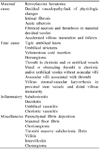Abstract
Objective
To evaluate placental causes of fetal death intrauterine (IUFD) bases on placental pathologic findings.
Methods
Retrospective review of 123 placental pathological reports of singleton fetal deaths from 20 weeks of gestation to 41 weeks of gestation.
Results
The incidences of maternal causes, fetal causes, inflammatory causes, miscellaneous and unremarkable findings were 45.5%, 28.4%, 16.2%, 23.5%, respectively. The incidence of fetal anomaly was 8.9%. Fetal anomalies were deeply related to fetal cause (P=0.000). Intrauterine growth restriction was significantly associated with maternal causes (P=0.038).
Conclusion
No pathological guideline regarding placental examination of intrauterine fetal death exists. In future studies, a better definition of fetal death causes and associated placental pathological findings might aid clinicians in counseling, assessing the risk of recurrence and even preventing fetal death in subsequent pregnancies.
Figures and Tables
Table 4
Placental pathologic findings of IUFD according to maternal age, parity and medical illness (preeclampsia and diabetes)

References
1. MacDorman MF, Munson ML, Kirmeyer S. Fetal and perinatal mortality, United States, 2004. Natl Vital Stat Rep. 2007. 56:1–19.
2. Silver RM. Fetal death. Obstet Gynecol. 2007. 109:153–167.
3. Fretts RC. Etiology and prevention of stillbirth. Am J Obstet Gynecol. 2005. 193:1923–1935.
4. Weintraub AY, Rozen A, Sheiner E, Levy A, Press F, Wiznitzer A. Perinatal mortality: a sporadic event or a recurrent catastrophe? Arch Gynecol Obstet. 2009. 279:299–303.
5. Smith GC, Fretts RC. Stillbirth. Lancet. 2007. 370:1715–1725.
6. Reddy UM. Prediction and prevention of recurrent stillbirth. Obstet Gynecol. 2007. 110:1151–1164.
7. Pitkin RM. Fetal death: diagnosis and management. Am J Obstet Gynecol. 1987. 157:583–589.
8. Horn LC, Langner A, Stiehl P, Wittekind C, Faber R. Identification of the causes of intrauterine death during 310 consecutive autopsies. Eur J Obstet Gynecol Reprod Biol. 2004. 113:134–138.
9. Varli IH, Petersson K, Bottinga R, Bremme K, Hofsjö A, Holm M, et al. The Stockholm classification of stillbirth. Acta Obstet Gynecol Scand. 2008. 87:1202–1212.
10. Kidron D, Bernheim J, Aviram R. Placental findings contributing to fetal death, a study of 120 stillbirths between 23 and 40 weeks gestation. Placenta. 2009. 30:700–704.
11. Gardosi J, Kady SM, McGeown P, Francis A, Tonks A. Classification of stillbirth by relevant condition at death (ReCoDe): population based cohort study. BMJ. 2005. 331:1113–1117.
12. Langston C, Kaplan C, Macpherson T, Manci E, Peevy K, Clark B, et al. Practice guideline for examination of the placenta: developed by the Placental Pathology Practice Guideline Development Task Force of the College of American Pathologists. Arch Pathol Lab Med. 1997. 121:449–476.
13. Redline RW. Inflammatory responses in the placenta and umbilical cord. Semin Fetal Neonatal Med. 2006. 11:296–301.
14. Chung WK, Kim H, Lee MJ, Lee DJ. A clinical study for fetal death in utero. Korean J Obstet Gynecol. 1993. 36:464–472.
15. Park SH, Park JW, Song HS, Kim SD, Ahn JY. The clinical study of intrauterine fetal death. Korean J Obstet Gynecol. 1994. 37:1541–1552.
16. Hey EN, Lloyd DJ, Wigglesworth JS. Classifying perinatal death: fetal and neonatal factors. Br J Obstet Gynaecol. 1986. 93:1213–1223.
17. Thornton CM, O'Hara MD. A regional audit of perinatal and infant autopsies in Northern Ireland. Br J Obstet Gynaecol. 1998. 105:18–23.
18. Wright C, Cameron H, Lamb W. The Northern Perinatal Mortality Survey Steering Group. A study of the quality of perinatal autopsy in the former northern region. Br J Obstet Gynaecol. 1998. 105:24–28.
19. Holt J, Vold IN, Odland JO, Forde OH. Perinatal deaths in a Norwegian county 1986-96 classified by the Nordic-Baltic perinatal classification: geographical contrasts as a basis for quality assessment. Acta Obstet Gynecol Scand. 2000. 79:107–112.
20. Park SH, Choi HM. A retrospective cohort study of maternal and perinatal risk factors on intrauterine fetal death. Korean J Obstet Gynecol. 2008. 51:965–973.
21. Eschler G, Heidegger H, Krone HA. Stillbirth-an analysis of 354 cases 1966-88. Geburtshilfe Frauenheilkd. 1991. 51:293–297.
22. Kunzel W, Misselwitz B. Unexpected fetal death during pregnancy-a problem of unrecognized fetal disorders during antenatal care? Eur J Obstet Gynecol Reprod Biol. 2003. 110:Suppl 1. S86–S92.
23. Abramowicz M, Barnett HL. Sex ratio of infant mortality. Am J Dis Child. 1970. 119:314–315.
24. Hankins GD, Longo M. The role of stillbirth prevention and late preterm (near-term) births. Semin Perinatol. 2006. 30:20–23.
25. Moyo SR, Hagerstrand I, Nystrom L, Tswana SA, Blomberg J, Bergstrom S, et al. Stillbirths and intrauterine infection, histologic chorioamnionitis and microbiological findings. Int J Gynaecol Obstet. 1996. 54:115–123.
26. Skjoldebrand-Sparre L, Nyman M, Broliden K, Wahren B. All cases of intrauterine fetal death should be evaluated for parvovirus B19 viral deoxyribonucleic acid. Am J Obstet Gynecol. 1999. 180:1595–1596.
27. Meyberg R, Boos R, Babajan A, Ertan AK, Schmidt W. Intrauterine growth retardation-perinatal mortality and postnatal morbidity in a perinatal center. Z Geburtshilfe Neonatol. 2000. 204:218–223.
28. Korteweg FJ, Gordijn SJ, Timmer A, Holm JP, Ravise JM, Erwich JJ. A placental cause of intrauterine fetal death depends on the perinatal mortality classification system used. Placenta. 2008. 29:71–80.




 PDF
PDF ePub
ePub Citation
Citation Print
Print







 XML Download
XML Download